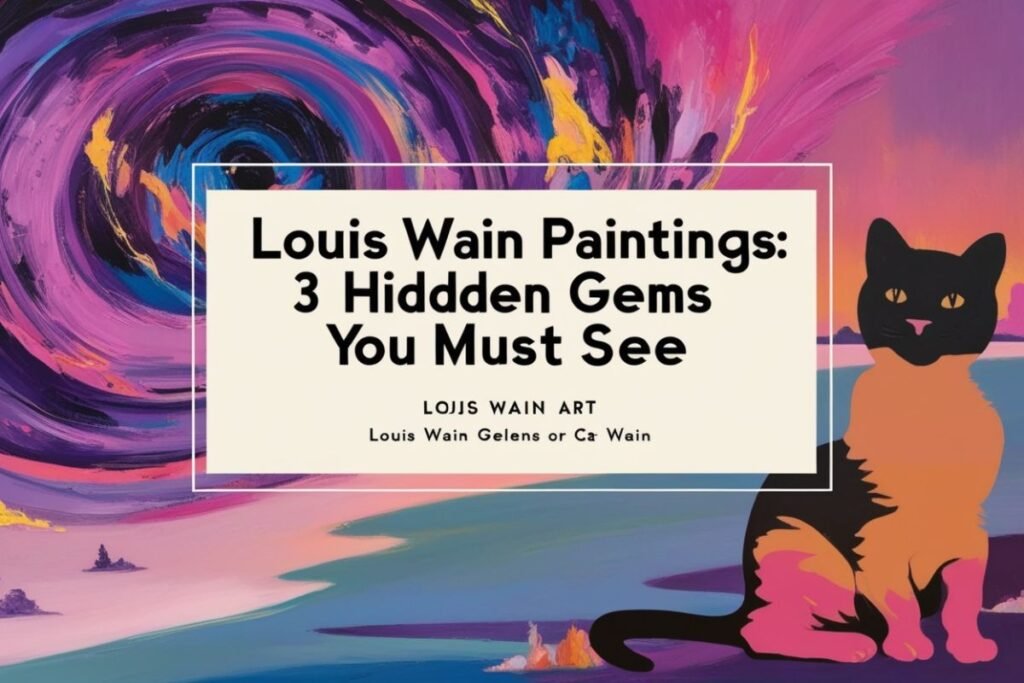Louis Wain Paintings, a name synonymous with cat paintings, has captivated art lovers for over a century. Known for his whimsical and vibrant portrayal of cats, Wain’s work evolved dramatically over time, from traditional portraiture to surreal, psychedelic depictions. While his most famous pieces are widely celebrated, there are lesser-known Louis Wain paintings that offer deeper insights into his unique artistry. However, like all artists, Wain’s journey was not without its pitfalls. In this article, we explore three hidden gems of Louis Wain paintings and some of the challenges and controversies surrounding his work.
Table of Contents
1. “Cat and Bird” (1912)
One of Louis Wain’s most intriguing works, Cat and Bird stands out not only for its captivating subject matter but also for its psychological depth. This painting, created during Wain’s later years when he was suffering from mental health issues, showcases a cat staring intently at a bird. The bold colors, swirling lines, and exaggerated facial expression of the cat suggest a mix of fascination and obsession. The piece is part of Wain’s transformation, moving away from traditional depictions of cats into more abstract, emotional representations. The hidden gem here lies in how the painting might offer a glimpse into Wain’s state of mind during a challenging period.
2. “The White Cat” (1904)
This lesser-known painting from 1904 features a strikingly elegant white cat with mesmerizing eyes, set against a bold, patterned background. The composition, while serene, is still packed with the vibrant energy typical of Wain’s work. The White Cat is often overlooked in favor of his more colorful and chaotic pieces, but it deserves attention for its subtlety and poise. The cat in the painting exudes both mystery and grace, reflecting the changing style of Wain as he moved from the more traditional, realistic approach in his early career to an increasingly stylized and expressive aesthetic. For those looking to understand the range of his artistry, this piece is a must-see.
3. “A Kitten’s Christmas” (1915)
“A Kitten’s Christmas” is a delightful example of Wain’s ability to capture the innocence and joy of kittens in a festive setting. While Wain’s later works became increasingly abstract, this particular painting is a return to a more charming and whimsical style. The playful kitten, surrounded by Christmas decorations, reminds us of the lighter side of Louis Wain’s art. This piece captures the joy of the holiday season and offers a heartwarming contrast to the darker, more introspective works created in his later years. A Kitten’s Christmas remains a hidden gem in the Wain collection, appealing to collectors and enthusiasts alike.
Pitfalls and Controversies Surrounding Louis Wain Paintings
While Louis Wain’s legacy is celebrated worldwide, his journey was not without its pitfalls. Throughout his life, Wain faced significant personal and professional struggles, including mental health issues that deeply influenced his artwork. The shifts in his style, particularly in his later years, sparked debate and criticism. Many critics dismissed his later works as chaotic and bizarre, unable to comprehend the connection between his deteriorating mental state and his increasingly abstract and colorful paintings.
Moreover, Wain’s work has often been pigeonholed into the niche category of “cat art,” which, while beloved, has sometimes limited the broader appreciation of his range as an artist. His ability to experiment with different styles, from early realism to psychedelic abstraction, has often been overshadowed by his association with the whimsical world of cats.
Despite these pitfalls, Louis Wain’s paintings continue to captivate audiences and collectors. His unique ability to convey emotion and personality through his feline subjects remains his greatest contribution to the art world.
FAQs
Q1: What makes Louis Wain paintings unique? Louis Wain paintings are unique due to their evolving styles, from realistic portraits to psychedelic and abstract depictions of cats. His use of vibrant colors and intricate patterns, especially in his later works, sets his art apart.
Q2: Why did Louis Wain’s style change so drastically? Wain’s style changed due to the effects of his mental health, which became more pronounced in his later years. The shift towards abstract and surreal depictions of cats reflected his psychological state and personal struggles.
Q3: Are Louis Wain paintings valuable? Yes, Louis Wain paintings are highly valued by collectors, especially his more famous works and the rare pieces that showcase his innovative use of color and form.


